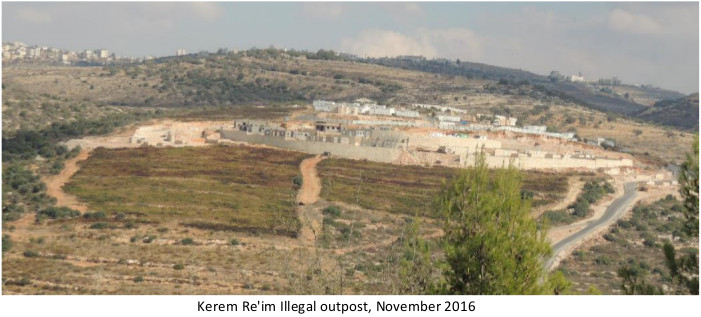Since the mid-1990s, the settlers established nearly 100 illegal outposts and built dozens of neighborhoods and illegal projects in many settlements. In 2015 alone 15% of the units constructed in the settlements was illegal.

During the past year, Settlement Watch conducted extensive research on illegal construction in settlements and
outposts. The data collected exposes a process parallel to the official planning process in the settlements – that
of illegal construction. This parallel process is what allows for thousands of housing units to remain on the
ground, and be connected to roads and infrastructure.
Peace Now's study reveals that three main bodies operate this parallel and illegal process: (1) Settlement Regional
Councils, (2) Settlement Division and (3) Amana. The Israeli government enables the illegal system to exist by
cooperating directly with these three bodies, by abstaining from law enforcement or prosecution, and by
retroactively legalizing the illegal constructions.
Through this illegal mechanism, Israeli governments have allowed a small group of settlers to set Israel's
settlement policy and thereby determine the future of Israel.
For the full report
For
a summary of the report
Key Findings:
- The ten stages of establishing illegal outposts: from paving roads and placing mobile homes to the administration and finance of the illegal outpost.
- Illegal construction permits issued by regional councils: These permits, referred to as “principle construction permits,” or “temporary construction permits” are meant to mislead a variety of different institutions, so that these are unable to tell that the construction is, in fact, illegal.
- Illegal construction funding through non-recurring expenses (NRE): NREs are on-time transfers from local authorities to specific projects and are usually nontransparent. Peace Now has managed to uncover that in the years 2000 – 2014, the Binyamin municipality authorized the transfers of over 116 Million NIS to illegal outposts and illegal projects.
- Amana's accumulation of capital with the help of the Settlement Division, and on the expense of the state and the settlers: The state grants the Settlement Division the authority to manage lands in the Occupied Territories. The Division then allocates lands to Amana for free. Amana builds, sometimes illegally, and sells homes to settlers in prices which embody the cost of the land. While the state does not receive any returns, Amana is making a fortune on the expense of the settlers.
- Illegal allocation of lands by the Settlement Division: Although the Settlement Division received enormous amounts of lands from the state throughout the West Bank, it allocates to settlers public lands that are not under its supervision. Not only that but the Settlement Division also allocates private lands owned by Palestinians (as in the example of the illegal outpost of Amona).
- The role of Amana as a settler lobby, a body that is “above the law,” despite many testimonies of illegal activity: Amana acts as the unofficial representative of the settlers, and raises private funding as well as public resources for the benefit of the settlements. Despite many testimonies regarding vast illegal activity, Amana manages, time after time, to avoid prosecution and punishment.